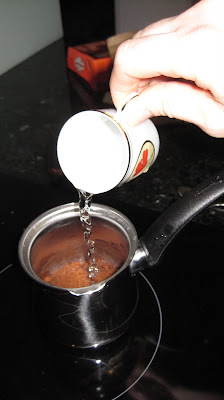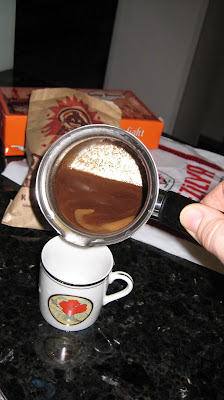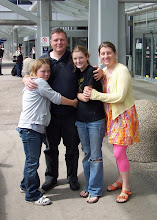 Step 1: Add one heaping spoon for one cup of coffee. Add sugar, if desired.
Step 1: Add one heaping spoon for one cup of coffee. Add sugar, if desired.Bryan likes his coffee with no sugar. I like mine Çok şekerli (pronounced CHOK sheh kehr lee), with a lot of sugar. Other sweetness options are Az şekerli (pronouned AHZ sheh-kehr-lee), which means a little sugar, less than a teaspoon per cup and Orta şekerli (pronounced ohr-TAH sheh-kehr-lee), which means medium sugar.
 Step 2. Fill the same cup you will use for your coffee with cold water and pour it into the pot.
Step 2. Fill the same cup you will use for your coffee with cold water and pour it into the pot. Step 3: Stir the coffee, optional sugar and water together at this point in the process (and at this point only).
Step 3: Stir the coffee, optional sugar and water together at this point in the process (and at this point only). Step 4: Bring the mixture to a slow boil (mine is probably boiling a little too much here).
Step 4: Bring the mixture to a slow boil (mine is probably boiling a little too much here). Step 5: Pour 1/3 of the coffee into the cup.
Step 5: Pour 1/3 of the coffee into the cup.
Step 6: Repeat steps 4 and 5 two more times, until you've poured all the coffee into your cup.
Enjoy!
The pot is called a cezve. Some are highly decorated and expensive ones can be made from hand-hammered copper. We like ours, an every-day one given to us by Ferda and Emre in Istanbul.
You can make coffee for multiple people at a time, as long as they all want it with the same level of sweetness. The only time to add sugar is before cooking, so if you might have to make a few different pots of coffee to accommodate different sweetness preferences. This is not a big deal, as making the coffee goes very quickly.
To make multiple cups of coffee, just adjust the number of spoonfuls and cups of water according to the number of people you're serving. So, for three people, use three spoonfuls of coffee and three cups of water (using the cups in which you'll be serve the coffee).
Here are some dessert photos from our lucky trip to Istanbul:
 We did not try the jarred nuts. I believe they're preserved in honey. On the right is burma kadayifi, which is shredded wheat rolled around chopped pistachios. At the bottom, I believe those would all be called lokum.
We did not try the jarred nuts. I believe they're preserved in honey. On the right is burma kadayifi, which is shredded wheat rolled around chopped pistachios. At the bottom, I believe those would all be called lokum.  Here's a close-up of the cookies Ferda bought at an Istanbul bakery. The pistachio shortbread type cookies on the right were my favorite. The ones in the middle had cherry pieces inside. ones in front were chocolate, and I don't remember what the whiter ones, on the left, were. Delicious!
Here's a close-up of the cookies Ferda bought at an Istanbul bakery. The pistachio shortbread type cookies on the right were my favorite. The ones in the middle had cherry pieces inside. ones in front were chocolate, and I don't remember what the whiter ones, on the left, were. Delicious!Istanbul's district called Kadikoy has housed the Saray restaurant since 1954. If you go there, you will likely be the only tourist. Originally, it only served Kazandibi, a dessert pudding made from milk and shredded chicken breast meat, and homemade-style chicken noodle soup, made from the remaining meat on the chickens. It would take me a bit of time to get used to the chicken taste in the pudding, but it wasn't bad at all, and I think that perhaps some protein in a dessert is not a bad idea.
The soup and Kazandibi are still popular today but have been joined by other dinner options and many more desserts.
 On the left is Firin Sütlaç, a type of rice pudding (this was Analeise's favorite dessert at Saray). On the right, in the back is Saray Mulhallebi, a rose-water pudding popular since the Ottomon times. In the foreground on the right is what I think is Kaymakli Ekmek Kadayifi, which is essentially a syrup-soaked bread.
On the left is Firin Sütlaç, a type of rice pudding (this was Analeise's favorite dessert at Saray). On the right, in the back is Saray Mulhallebi, a rose-water pudding popular since the Ottomon times. In the foreground on the right is what I think is Kaymakli Ekmek Kadayifi, which is essentially a syrup-soaked bread.  This photo shows my favorites from the evening's sampling. On the left is a delicious Quince dessert called Kaymakli Ayva Tatlisi. On the right is Aşure, or Noah's Pudding. Among other things, it contains wheat, beans, chickpeas, pomegranate seeds, and finely chopped pistachios. Tradition holds that Noah made this dish after the flood was over, using fruits and grains that were stored on the arc. It's a very old recipe, and it was delicious. I'd never thought of beans and chickpeas in a dessert, but they really work!
This photo shows my favorites from the evening's sampling. On the left is a delicious Quince dessert called Kaymakli Ayva Tatlisi. On the right is Aşure, or Noah's Pudding. Among other things, it contains wheat, beans, chickpeas, pomegranate seeds, and finely chopped pistachios. Tradition holds that Noah made this dish after the flood was over, using fruits and grains that were stored on the arc. It's a very old recipe, and it was delicious. I'd never thought of beans and chickpeas in a dessert, but they really work!Websites:
Only in Turkish, here's the restaurant Saray's website:
http://www.kadikoysaray.com/
This site offers very detailed Turkish-coffee-making instructions, slightly different from mine (hello, Kate Hearley!): http://www.howtobrewcoffee.com/Turkish.htm


No comments:
Post a Comment